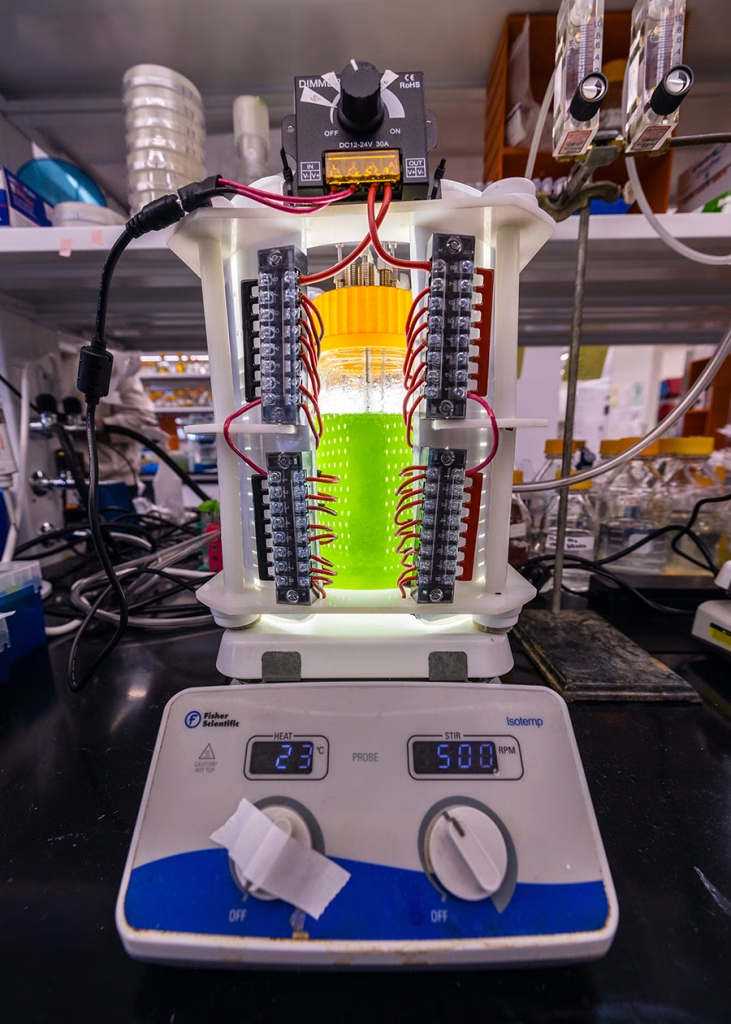A team of chemical and biological engineering researchers at the University of Wisconsin-Madison has developed a new strain of cyanobacteria, also known as blue-green algae, which takes up 8.5 times the phosphorus compared to its wild counterpart.
These supercharged bacteria are at the heart of the team’s new manure-treatment system, which prevents phosphorus in livestock waste from dairy farms from polluting waterways.
“Farmers are in a place where they can’t operate more sustainably because of profit margins, and the state can’t force them to because it would be either too expensive or would harm the farm industry,” says Ted Chavkin, a postdoctoral scholar in chemical and biological engineering.
Chavkin, who works in the lab of Brian Pfleger, a UW-Madison professor of chemical and biological engineering, is co-lead author of a paper describing the work in the journal ACS Sustainable Chemistry & Engineering. “It’s the perfect situation for new technology to try to fix the problem,” says Chavkin.
The study is part of long-term National Science Foundation-funded project led by Professor Victor Zavala Tejeda in collaboration with Pfleger, along with Professor Rebecca Larson of the Nelson Institute for Environmental Studies.
Phosphorus pollution is a problem around the world; the nutrient, which is mined from phosphate deposits, is critical to crop growth and is a big element in synthetic fertilizers as well as manure, which is often spread on farm fields. The problem is that overapplication of manure causes phosphorus to build up in the soil over time. When the nutrient is washed into streams, rivers and lakes, it can power cyanobacteria blooms. This blue-green algae produces toxins that are harmful to humans and animals and can lead to giant, smelly algae blooms in the lakes, which can ultimately hinder tourism, property values, and recreational activities.
To keep the phosphorus in manure out of the water, the UW-Madison team has developed a nutrient capture system that allows its algae to gobble up all the phosphorus it wants in a controlled bioreactor. Then they dry the phosphorus-rich algae, turn it into powder, and create a fertilizer. Not only does the system reuse phosphorus in a more controlled way, but it also creates a more circular, sustainable system that potentially gives dairy and livestock farmers another income stream.

Over the last few years, the team has worked to refine its system, figuring out ways to make it more resource-efficient and cost-effective. To that end, recent PhD graduate Leo Gonzalez, who worked in Zavala’s lab, modeled the process using wild cyanobacteria, identifying areas where changing variables could make the most impact. One of those changes was to improve, by about 25%, how much phosphorus the cyanobacteria can take up.
That’s the task Chavkin took on. In cyanobacteria, phosphorus uptake is energy-intensive, meaning the cells heavily regulate the process. Chavkin, however, found that increasing expression of a specific gene caused the algae to take up a lot more phosphorus. “We realized if we broke the system, then we could trick the cyanobacteria into making fewer cells with more phosphate per cell,” he says. “We didn’t increase phosphorus uptake by 25%; we increased it by 850%—and so we got much better results than we were even predicting.”
That increased uptake means it takes just a fraction of the cyanobacteria previously needed to slurp the phosphorus out of a batch of manure. Computer modeling shows these super algae change the overall system in other big ways as well: They completely eliminate the need for added fresh water, cut overall costs in half, and reduce energy use by two-thirds. The cyanobacteria also use up all of the carbon dioxide produced in the process, which limits emissions from the system.
Chavkin says the team plans to optimize the system even further. The researchers will test adding other bacteria to the process that could produce additional chemicals or nutrients from the manure, making it even more cost-effective.
Putting the system into practice will require the team to work with farmers to showcase the benefits of algae-based biofertilizer. But the researchers are optimistic prototype systems will be munching away on manure relatively soon.
“I’ve been surprised at how bad the phosphorus problem is in the Midwest and how much we need a solution,” says Chavkin. “Our other projects are often making products that are not going to hit the market for 20 or 30 years. What I’m excited about is trying to fix this using the techniques that we work on, day in and day out, and getting real-world results in a shorter timeframe.”
Victor Zavala is the Baldovin-DaPra Professor. Brian Pfleger is the Karen and William Monfre Professor and Vilas Distinguished Achievement Professor. Other UW-Madison authors include Brenda Cansino-Loeza and Rebecca Larson.
The authors acknowledge support from NSF award #2132036; an NHGRI training grant to the Genomic Sciences Training Program 5T32HG002760; the University of Wisconsin Graduate Engineering Research Scholars Fellowship and the PPG Fellowship.
Top image caption: Postdoctoral scholar Ted Chavkin is designing new strands of cyanobacteria for a manure processing system to combat phosphorous pollution. Photos: Joel Hallberg.